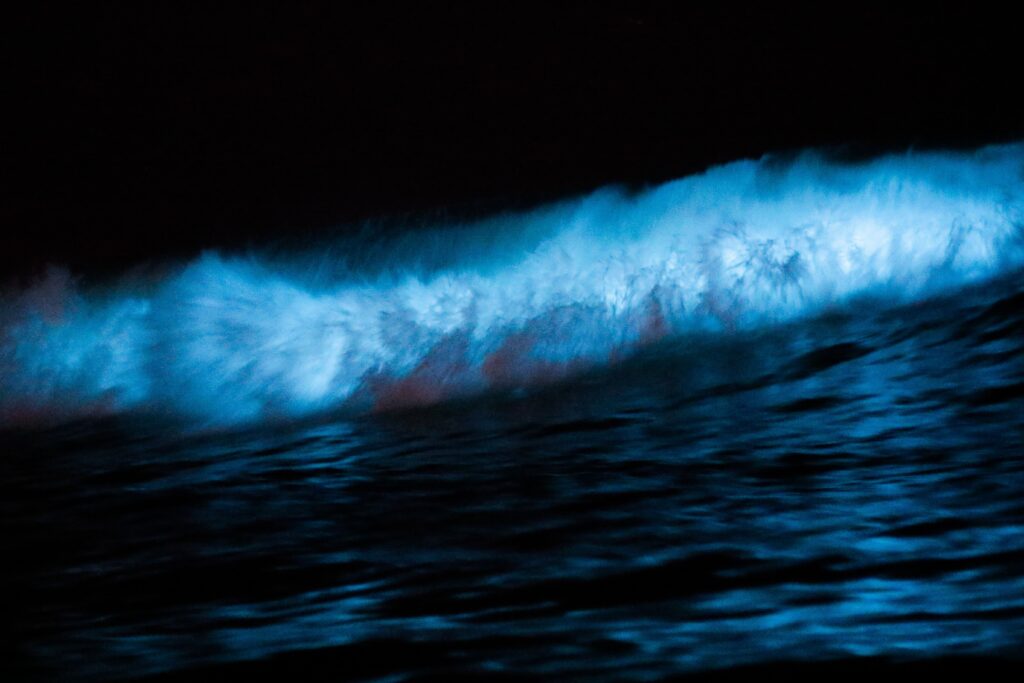Puerto Rico is quite famous for doing bioluminescence tours there. I spend a couple of days in Vieques, an island easy to reach from the mainland. Together with a friend of mine we have booked a Kayak Tour to see Mosquito Bay’s bioluminescence. When we started paddling in the water, the sky was almost dark. I looked down at my paddles, hoping to catch a glimpse of the neon glow in the water. As my paddles strained the water, the glow became apparent. The water seemed to change colour around the paddles to a brighter tone. As I placed my hand in, the water around it began to sparkle. What mysterious phenomenon causes water to glow like neon flashes? The answer is bioluminescence. So let´s discover how bioluminescence works.
What is bioluminescence?
“Bioluminescence is light produced by a chemical reaction within a living organism” (National Geographic, s.a.). What differentiates bioluminescence from fluorescence is that bioluminescence does not require the prior absorption of energy in the form of sunlight. This reaction is primarily enabled by a special protein, more specifically an enzyme, which we will examine in greater detail later in this post. 1
Examples for bioluminescent animals
The ocean is home to the vast majority of bioluminescent organisms. Dinoflagellates, bacteria, mollusks, and bony fish are some examples. They emit light in a number of different patterns. Dinoflagellates produce flashes of light, whereas dragonfish create a continuous glow. 1 There are, however, a few land-based bioluminescent organisms. One example is fireflies. You may have already noticed them lighting up a dark night. 2
How does bioluminescence work?
Let´s continue with how bioluminescence works. The tour guide explained that dinoflagellates are responsible for the water’s glow in this case. Dinoflagellates are “tiny marine organisms” (National Geographic, s.a.) that represent a type of plankton. 3 They produce light through a chemical reaction known as the luciferin-luciferase reaction. Luciferin is the substrate in this reaction, and Luciferase is the enzyme that catalyses it. 1 If you’re unfamiliar with the terms enzyme and substrate, don’t worry. You will understand their interaction in a second.
The molecule Luciferase reacts together with oxygen to form an excited intermediate. The protein Luciferase enables and accelerates this reaction. These energetic intermediates emit energy when they return to their ground state. 1 This is the energy that appears as a glow in the water. You can imagine that this intermediate goes from a higher to a lower energy level. Since energy can´t be lost, it is released as light.
What is the origin of bioluminescence in terms of evolution?
That all sounds very nice, you might say, but what is the point of producing bioluminescence in these organisms? What exactly is the purpose of bioluminescence? The function of bioluminescence varies depending on the organism. 1
Firefly larvae, for example, use their glow to warn predators that they are unpalatable. The flash patterns of adult fireflies are often exclusive to a species and they use them to identify their members. Female fireflies choose mates based on their flash patterns, according to research on two different firefly species. Males who flash more frequently and with greater intensity appear more appealing to females. 2
Another function of bioluminescence is explained in the video below.
Conclusion
In this blog post we´ve learned how bioluminescence works: A chemical reaction produces bioluminescence within organisms. Oxygen and Luciferin combine to form an excited intermediate. Luciferase is an enzyme required for this reaction. When this intermediate returns to its ground state, it emits energy in form of blue light.
References:- Kahlke, T. and Umbers K., 2016. Quick guide Bioluminescence. Current Biology, Vol.26, Issue 8, 313-314.
- Scientific American, 2005. How and why do fireflies light up? Available at : https://www.scientificamerican.com/article/how-and-why-do-fireflies/ [24.01.2023].
- National Geographic, s.a. Bioluminescence. Available at : https://education.nationalgeographic.org/resource/bioluminescence [23.01.2023].

 To provide scientific knowledge on this site for free means a lot to me. However, researching and writing costs me a lot of time. Since I´m a student, financial support for my blog post helps me to maintain scientific quality.
To provide scientific knowledge on this site for free means a lot to me. However, researching and writing costs me a lot of time. Since I´m a student, financial support for my blog post helps me to maintain scientific quality.